2017 Seminar Series
Thursday 16th February 2017 With the growing population and evolving dietary habits, meeting the world’s growing demand for high quality animal protein is becoming a global societal challenge. The conventional solution to compensate for protein deficiencies in poultry diet is the ‘more of the same’ approach, to add more plant based protein to the feed-when the real issue is the amino acid balance. As conventional feed ingredients for animal production are deficient in one of the essential amino acids, targeted supplementation of amino acid ensures healthy, balanced nutrition for optimum growth. Lowering the plant based protein requirements not only reduces the animal producers total feed cost but also helps conserve crop resources. The reduction in plant based protein intake also reduces the amount of manure as well as effluents that leads to eutrophication. Amino acids supplemented poultry diets thus contribute to more efficient animal production, reduce burden on the environment and a deliver healthier high quality protein for human consumption. Girish Channarayapatna completed his PhD in 2009 from University of Guelph, Animal and Poultry Science Department, Canada. His main research focus during PhD was on mycotoxicoses in poultry. He joined Evonik in March 2010 as the Technical Sales Manager for Asia South region. Since 2014 he is heading the Technical Service Group for Evonik Animal Nutrition in Asia South. Tuesday 18th April 2017 The chicken meat industry is growing rapidly due to its affordability as an animal protein source and low production costs. Current broiler feed protein levels are correlated with high water consumption and wet litter, resulting in health and welfare issues. Domestic protein meals used in poultry feed can be unreliable or hold ant-nutritive factors causing a dependence on imported soybean meal, adding extra costs to feed formulations. Amino acid supplements are a viable option in fortifying low protein diets by meeting nutritional requirements of growing meat chickens that are lost when reducing dietary protein. To maintain a cost-effective practice only a few amino acid supplements are used in the Australian meat chicken industry, however with a trend towards more amino acid supplements becoming affordable, research has been undertaken to assess the feasibility of their use on meat chicken performance. The implementation of low protein diets will reduce industry dependence on protein meals and the adverse health and welfare effects of higher protein diets. Recently at UNE, a study was completed investigating the effects of low protein diets fortified with essential and nonessential amino acids on meat chicken performance and water intake. Tuesday 2nd May 2017 Vigorous or severe feather pecking (SFP) is forceful pecking or pulling of feathers which can lead to plumage deterioration, skin lesions and in severe cases, death. SFP can trigger cannibalism, predisposing serious welfare problems, whilst the cause is considered to be multifactorial. In some experiments environmental enrichment has been shown to reduce feather pecking. Recently pecking stones (containing minerals Ca and P) were used as a tool for reduction of feather pecking, and therefore improved welfare practice. The aim of this research was to investigate the effects of pecking stones, housing system and flock age on plumage condition and health parameters of free range laying hens. Tuesday 9th May 2017 The use of antibiotics as growth promoters in animal feed began in the 1940s, with two scientific papers being widely cited as the first scientific papers to report a growth-promoting effect of feeding antibiotics. Subsequently, antibiotics quickly made in-roads into the poultry industry. The use of antibiotics in the light of their potential for the development of antibiotic resistance in bacteria was later investigated. It is suggested that sub-therapeutic levels of antibiotics in the diet of farm animals may pose certain hazards to humans and animal health. In particular, sustained feeding of antibiotics causes antibiotic resistance of enteric bacteria in the animal gut. Because of this and observation of resistance of disease causing bacteria in hospitals routine use of antibiotics for growth promotion have been banned in the EU. Animal nutritionists all over the world have been called to find non-antibiotic growth promotants as alternatives to antibiotics. Much research has been conducted in this regard, especially for potential infections that might occur as a result of feeding strategies such as the inclusion of poorly digested by-products such as meat and bone meal. Non-starch polysaccharides from wheat and barley have also been known to cause enteric problems in poultry diets. While NSPase enzymes are widely used in poultry feed there is paucity of information whether commercial enzymes could act to promote growth. An ongoing investigation is looking at the possibility of eliminating necrotic enteritis, a bacterial disease, in broilers fed diets with high levels of protein by-product (meat and bone meal) using phytase (a commercial enzyme). This seminar will focus on a brief history of antibiotics, development of resistance in bacteria and how exogenous feed enzymes might help reduce subclinical bacterial diseases in poultry. Tuesday 16th May 2017 Traditional genetic improvement relies on the use of pedigree information and phenotypes of each animal to estimate its breeding values. This has led to substantial genetic gains in most livestock species, especially for the traits that are easy to measure. However, the process is often inefficient for expensive or difficult to measure traits such as parasite resistance. Genomic selection offers an alternative to conventional breeding programs and can increase the rate of genetic gain by using genomic information to predict the breeding values of selection animals. This study aimed to compare the accuracy of genomic prediction based on different SNP panel densities, with and without including genetic markers from quantitative trait loci (QTL) regions. The results show that accuracy of prediction can be improved by including QTL information explicitly in the prediction models. Tuesday 23rd May 2017 Even under the best management practices, stressful events can occur during an animal's life including pregnancy. Previous studies in humans and mammals have shown that certain stressful situations can impact negatively the foetus brain development which could result in impaired behaviour and cognitive abilities in the neonates. Early behaviours are primordial for newborn lambs to establish a bond with their dam as well as follow their dam and so for survival. We have investigated the effects of different mild stressors at different stages of pregnancy on lamb neonatal behaviour. We also compared these effects with those of the injections of stress hormone noradrenaline as an attempt to shed some light on the mechanisms behind the effects observed. Tuesday 6th June 2017 Enteric methane (CH4) is produced by ruminants during the fermentation of the feed. At global level livestock emits in the atmosphere 18% of the total anthropogenic emissions. Livestock animals are rising to respond to the growing demand of food. Reduction of CH4 from livestock is possible through various strategies. Dietary strategy appears to have encouraging results on reducing CH4 without lowering the productivity of the animals. Nitrate salts and dietary oils have been among the most promising additives. Nitrate may also replace urea as a non-protein-nitrogen source in protein-deficient diets. More recently, cysteamine hydrochloride (CSH) has been shown as an effective antimethanogenic additive and may increase the productivity of animals in intensive systems. We investigated the effect of feeding nitrate, canola oil or CSH on CH4 emissions and the role of nitrate and CSH as feed additives in low-quality roughage diets. Laura Villar is an Agricultural Engineer in her second year of her PhD. Laura is investigating the effect of feed additives on reducing methane emissions, focusing on nitrate metabolism in the rumen, using respiration chambers to measure methane production from ruminants. Laura received a scholarship from the National Institute for Agricultural Research from Argentina (INTA), where she has been involved with small ruminant research in extensive conditions in Patagonia for 10 years. After completion of her PhD, Laura plans to contribute ideas for methane mitigation strategies by using feed additives in Argentina. Wednesday 7th June 2017 Salt tolerant pasture species represent a valuable opportunity to intensify agricultural production in low-rainfall areas where saline land and or water (e.g. mine-site dewatering) are allocated to pastoral systems. Inherently variable in ionic composition and concentration, the response of plants to saline soils and groundwater are difficult to predict. Existing and novel approaches were applied to tropical and sub tropical pasture species to identify: mechanisms of tolerance to root-zone salinity; the individual effects of osmotic stress (OS) and osmotic stress and ion toxicity (OST) on plant growth and water use and; practical upper salinity limits for soil solution salinities. Generally, salt tolerant tropical and subtropical pasture species, including some glycophytes, should be considered for intensification of agricultural production in areas where root-zone salinity is an issue. The ability of glycophytic pasture species such as lucerne and leucaena to exclude Na+ at the root level, when root-zone Ca2+ was adequate, has potential value under root-zone salinity. However, if OST occurred, severe reductions in growth and plant water use were observed, potentially limiting glycophytes to situations where low soil solution salinities (2-5 dS/m) and adequate Ca2+ availability can be maintained. The capacity of halophytic Rhodes grass to safely accumulate ions to high concentrations in plant tissues at moderately high root-zone salinity (16 dS/m), whilst maintaining adequate plant growth and water use, meant it was the best option (of the species tested) for cultivation in tropical and subtropical areas affected by root-zone salinity. Biography Hayley is an agronomist and Lecturer in Tropical Agriculture at The University of Queensland. Her research interests range from the systems level of ruminant livestock production down to cellular processes, studying the physiological responses of pastures to abiotic stress. Hayley completed her PhD at the University of Queensland, studying the effects of root-zone salinity on plant production and water use of tropical and subtropical pasture species adapted to southern Queensland. She has experience in the intensive and extensive grazing systems of northern Australia, and agricultural research in South East Asia. Hayley has worked on a variety of research and extension activities associated with feed base improvement, plant breeding and toxicology. Tuesday 13th June 2017 The interest for feed efficiency has increased at least over the last two decades. Not only because is important to increase food production due to the growing human population, but also because feed efficiency is related with the feed cost of production. Providing feed to animals is a major cost input in almost any animal production system. The efficiency of converting this feed into useable animal products, commonly referred to as feed efficiency, is becoming a common breeding objective to improve profitability. In order to include feed efficiency traits in the breeding goal or breeding objective, genetic parameters are needed for accurate and unbiased prediction of breeding values, as well as to develop selection indices, and to predict selection responses. We investigate the genetic parameters of some feed efficiency traits and its genetic correlations between traits. Potential exist to reduce beef cost by selecting for low values for residual feed intake in breeding programs, and the major cattle breed societies in Australia are measuring feed efficiency traits to include them into the Australian beef recording system “Breedplan”. Antonio Torres-Vazquez is a veterinarian in his first year of his PhD. His research interest ranges from estimation of genetic parameters to optimisation of breeding programs. Antonio has completed a Master in Science with specialization in Animal Breeding and Genetics and currently is investigating the genetic variability of feed efficiency traits in Australian Angus Cattle. Tuesday 20th June 2017 Shell colour is an important trait for eggs and an understanding of pigment deposition will assist potential management of egg shell colour loss. We demonstrated that nicarbazin feeding down-regulated ALAS1 and reduced protoporphyrin IX (PP IX) in both shell gland and eggshell, indicating the role of nicarbazin in inhibiting the synthesis of PP IX. Additionally, the expression levels of the genes did not show sequential upregulation in the same order of diurnal time-points (TP) during egg formation. The gene SLC25A38, responsible for transporting glycine from cytoplasm to mitochondria, and the gene ALAS1,encoding rate-limiting enzyme (delta-aminolevulinic acid synthase 1), had higher expression at 15 hr, as compared with 2, 5 and 23.5 hr postoviposition. Interestingly, ABCB6, a gene encoding an enzyme responsible for transporting coproporphyrinogen III, showed higher expression level at 2 and 5 hrs. However, the expression of CPOX that converts coproporphyrinogen III to protoporphyrinogen III, and ABCG2 that transports PP IX out from mitochondria did not alter. Nevertheless, mitochondrial count per cell did not show consistent change in response to time-points postoviposition and nicarbazin feeding. The information obtained in the study sheds light on how nicarbazin disrupts the synthesis of PP IX. Tuesday 27th June 2017 RNA sequencing is a powerful tool that allows us to study the differences in gene expression and their association with different phenotypes, tissues, treatments or diseases. It provides us with a better understanding on how specific conditions impact biological processes and how abundances of different genes (transcripts) vary. This technique is based on counting the number of sequences that map to a reference genome and then the abundances of the genes in two different conditions (or tissues) are contrasted. In beef cattle, the composition of the meat (texture, muscle fibres, etc.) changes from one muscle type to another; this is the reason why we were interested in studying the early biological triggers of muscle differentiation during development (myogenic process). Here we used Korean cattle (Hanwoo) to identify the genes and pathways that regulate these processes. A cell culture experiment using bovine muscle satellite cells from Longissimus dorsi and Semimembranosus was combined with a time-series RNA-seq analysis to measure the transcriptome expression levels during the differentiation of satellite cells (on days 0, 1, 2, 4, 7 and 14). Around 84% of the reads were mapped to the reference genome (Bos taurus UMD3.1). Several genes were differentially expressed across time and between tissues. Gene ontology analysis revealed that the main enriched terms were genes with functions necessary for regulation of cell cycle, mitosis, nuclear division, cell cycle checkpoints and DNA biosynthetic processes. The most important finding was the identification of Hoxc11, Sim2, Hoxc8, Hoxb9, Zic2, Zic4, Tbx4 and Hoxb4 genes that were differentially expressed between LD and SM across time, suggesting that they could be driving the specific characterization of each muscle.January - June
Tuesday 4th July 2017 The poultry nutrition group at UNE has successfully developed equations to predict the net energy of feed ingredients based on metabolisable energy and measured chemical components. A series of metabolic experiments were conducted using closed circuit respirometer chambers to measure oxygen consumption, carbon dioxide generation and overall energy balance in both meat chickens and laying hens fasted and fed diets differing in nutrient and chemical composition. The data collected on heat production, metabolisable energy, body weight, and chemical composition of the diets was analysed using linear regression to develop equations for meat birds and layers to be applied to individual feed ingredients. New feeds were formulated using net energy and fed to birds in chambers to validate the equations. The results indicate that in addition to metabolisable energy, protein and fat are significant predictors of heat increment in poultry. The economic benefit to formulating using net energy over metabolisable energy depends on the relative price of various ingredients including fats and oils and more recently commercialised amino acids such as arginine, isoleucine and valine. Biography Bob Swick is a native of the USA. Prior to his current position he lived in Singapore and consulted for the American Soybean Association, Agrenco Bioenergy, Prince Agri Products and ADDCON. He received his PhD in animal nutrition from Oregon State University in 1981 and began his career at Monsanto Company working with methionine and feed preservatives. He later became Product Development Manager at Novus International. Bob has published over 250 technical papers, bulletins, reports and journal articles and holds a patent on a novel grain preservation system. His current research interests are in the area of poultry energetics, nutrient metabolism and gut health. Tuesday 25th July 2017 Can we use invisible fences to control sheep? There is increasing development in virtual fencing systems to contain and control the movement of livestock. Unlike traditional fencing that uses a physical barrier that animals can see and interact with, virtual fencing relies on animals interacting with the invisible fence through warning cues and negative stimuli. To ensure animal welfare is not compromised when using virtual fencing, animals must be able to associate a benign conditioned stimulus with an aversive stimulus. The aims of this study were to identify the minimum aversive stimulus that deters animals, and to develop a training method based on associative learning. Biography Danila completed a PhD investigating self-medication methods in sheep and cattle at the UNE and CSIRO. Danila currently works in animal behaviour and welfare with CSIRO Armidale, with a primary focus on sheep welfare. She is interested in the learning capabilities of livestock and how we can develop training protocols that could allow them to have control over their welfare. Tuesday 25th July 2017 As animal welfare becomes an increasingly important consideration for society, we need to develop practical measures of welfare which take into account both physical and mental well-being. It can be very difficult to determine the effective or emotional state of animals and existing cognitive methods can be very time consuming and impractical in applied contexts. This study aimed to further validate and refine a cognitive method which has been pharmacologically validated as a measure of anxious states in sheep. The results of this study show the test can be refined and shortened to less than 3 minutes per sheep, allowing for faster assessment of anxious states in larger groups of animals. Biography Jessica is in the second year of her PhD studying the behavioural and physiological coping strategies that livestock use to deal with management induced stress. Tuesday 8th August 2017 Monitoring the health of extensively managed sheep can be difficult and labour intensive, so the development of remote and automated monitoring technologies may be of use in assisting producers in the early detection of illness and disease. The first part of this study involved examining the potential for temperature sensing microchips placed in peripheral areas of the body for detecting changes in core body temperature. The second part investigates the potential for the use of infrared thermography in the detection of skin inflammation in wooled areas of sheep. The results of these two studies show that placement of microchips influences their ability to accurately reflect core temperatures, and that the presence of wool longer than 1-2mm significantly impacts on the ability of infrared thermography to detect skin inflammation. Tuesday 29th Ausgust, 2017. Influential economist Jeffrey Sachs and tech-friendly institutions such as the Bill and Melinda Gates Foundation (BMGF) believe that modern technologies can be used to transform the agriculture development process. Others point to the long list of silver bullet technologies that have done little but Biography John Gibson is Professor and Director of International Development and Director of the Centre for Genetic Analysis and Applications in the School of Environmental and Rural Science at UNE. Previous appointments have included Transitional Head of School for ERS at UNE; Program Director of Genetics and Tuesday 26th September, 2017. Infectious bronchitis is an acute and highly contagious disease of chickens which is caused by a coronavirus. As the name suggests, it affects the respiratory system but also other organs including the kidneys, oviduct and gastrointestinal tract. The presence of the disease in Biography Julie Roberts completed an Honours degree in Zoology at James Cook University and a PhD in Animal Physiology at Flinders University. She then worked for a short while in the Department of Physiology at the University of New South Wales before completing Postdoctoral Fellowships at the University Tuesday 3rd October, 2017. Measures to improve nutrient digestibility, gut health and bird performance and welfare have been sought due to the imminent phase out of in-feed antibiotics in poultry and continued demand for higher poultry feeding efficiency. A study was conducted at UNE, as a part of PhD project, to promote gizzard Tuesday 3rd October, 2017. Range use by laying hens is associated with better animal welfare due to the access to a more natural environment and more chances to do natural behaviours which leads to better leg bone development, fewer gait problems and reduced risk of feather pecking. However, obtaining good flock uniformity of Tuesday 17th October, 2017. Free-ranging dogs (FRDs) are common pets in remote Aboriginal communities for many reasons including (companionship, hunting, warmth and kinship). Cats have recently become increasingly kept as pets. With issues such as overpopulation, poor animal welfare, zoonosis, and predation of wildlife by FRDs and cats, management needs to be improved. Animal health programs have been implemented in many remote Aboriginal communities where a veterinarian delivers de-sexing, parasite control and voluntary euthanasia. However, due to financial restrictions many of these programs are not frequent enough to fully ‘manage’ a population. Collaborations have occurred, with Outsiders, which were successful for a number of years until the funding stopped. My PhD focuses on a framework we designed to encourage and assist local Aboriginal people to raise an issue, discuss its impacts and causes and how to intervene. Capacity building will be incorporated into all aspects including how to monitor their interventions including census taking and wildlife surveys. This talk will briefly discuss the framework as a whole and detail the baseline data and the first phase: Identifying the issue. Biography Brooke completed her Bachelor of Zoology here at UNE along with her Honours in Animal Science. Now in her 1st year of her PhD, she is looking to improve the welfare of companion animals in remote Aboriginal communities as well as building the capacity of the community by involving them in all aspects of the research. Tuesday 29th August, 2017. ASKBILL is a web-based program that uses farm measurements, climate data and information on genetics to predict pasture growth, animal performance and animal health and climate risks. The program uses several biophysical models, and the animal growth model can be used estimate supplementary feeding Tuesday 31st October, 2017. Antibiotics have been used for many decades to improve performance and to maintain the health integrity of animals. However, due to the emergence of antibiotic-resistant bacteria some of which are pathogenic to humans, the European Union placed a ban on in-feed antibiotics usage over two decades ago, Tuesday 7th November, 2017. The effects of sprouted barley fodder and feedlot finisher diets on rumen fermentation parameters, nutrient digestibilities and enteric methane production were investigated in a 42-d completely randomised design using 18-19 month old beef cattle (348 16.1 kg). It was hypothesised that same source Tuesday 28th November, 2017. The most important economic factor in broiler production is feed cost where energy sources represent a major part. The maximisation of feed energy utilisation is therefore the major target of a nutritionist. This can be done by using feed supplements, as well as accurately measuring the useable feed Tuesday 3rd October, 2017. A common breeding objective for Angus beef producers in Australia is improving the carcase quality of animals in their breeding program. Traditionally, direct carcase traits like intramuscular fat (IMF) and marbling score have been expensive and difficult, if not impossible to measure on selection candidates. Due to this limitation, breeders can use a correlated ultrasound scan measurement on the live animal to increase selection accuracy at the point of selection. The most common ultrasound scanning technology used to predict carcase IMF in Australian Angus herds is the Esaote Aquila system produced by Pie Medical (PIE). This technology allows crush-side and real-time image capture, interpretation and analysis using inbuilt software and algorithms. An alternative approach for the prediction of carcase IMF is the Central Ultrasound Processing (CUP) system. The CUP system uses unique software and algorithms to predict carcase IMF through a centralised image analysis laboratory on images which are also captured crush-side through ultrasound scanning. This seminar will present findings comparing the phenotypic and genetic parameters for the two live-animal ultrasound systems (PIE and CUP) and their relationship with carcase IMF and marbling scores. Results indicate that the CUP ultrasound scan technology is most suitable for genetic evaluation of Angus cattle for IMF. Tuesday 12th December, 2017. Many longer term effects of preterm and dysmature (small for gestational age) birth in equines are currently unknown. We know that foetal stress occurs, due to problems such as undernutrition, placentitis, and hypoxia, and/or environmental stresses that affect the dam, and that any one of these can lead to prematurity and low birthweight. Although the ongoing musculoskeletal issues associated with prematurity or dysmaturity at birth are frequently observed, research into permanent endocrinological issues caused by stress in the perinatal period remains highly limited. This study investigated whether healthy horses with a history of prematurity or dysmaturity at birth present a degree of adrenocortical dysregulation that persists beyond the juvenile phase and into adulthood, potentially leading to a different response to stress in these horses. Tuesday 12th December 2017. \ Village chickens are a major component of poultry in many developing countries. These birds use negligible inputs and labour to produce high quality protein, they are a source of income, manure for crop production and they are used for socio-cultural purposes. But, despite their significant contribution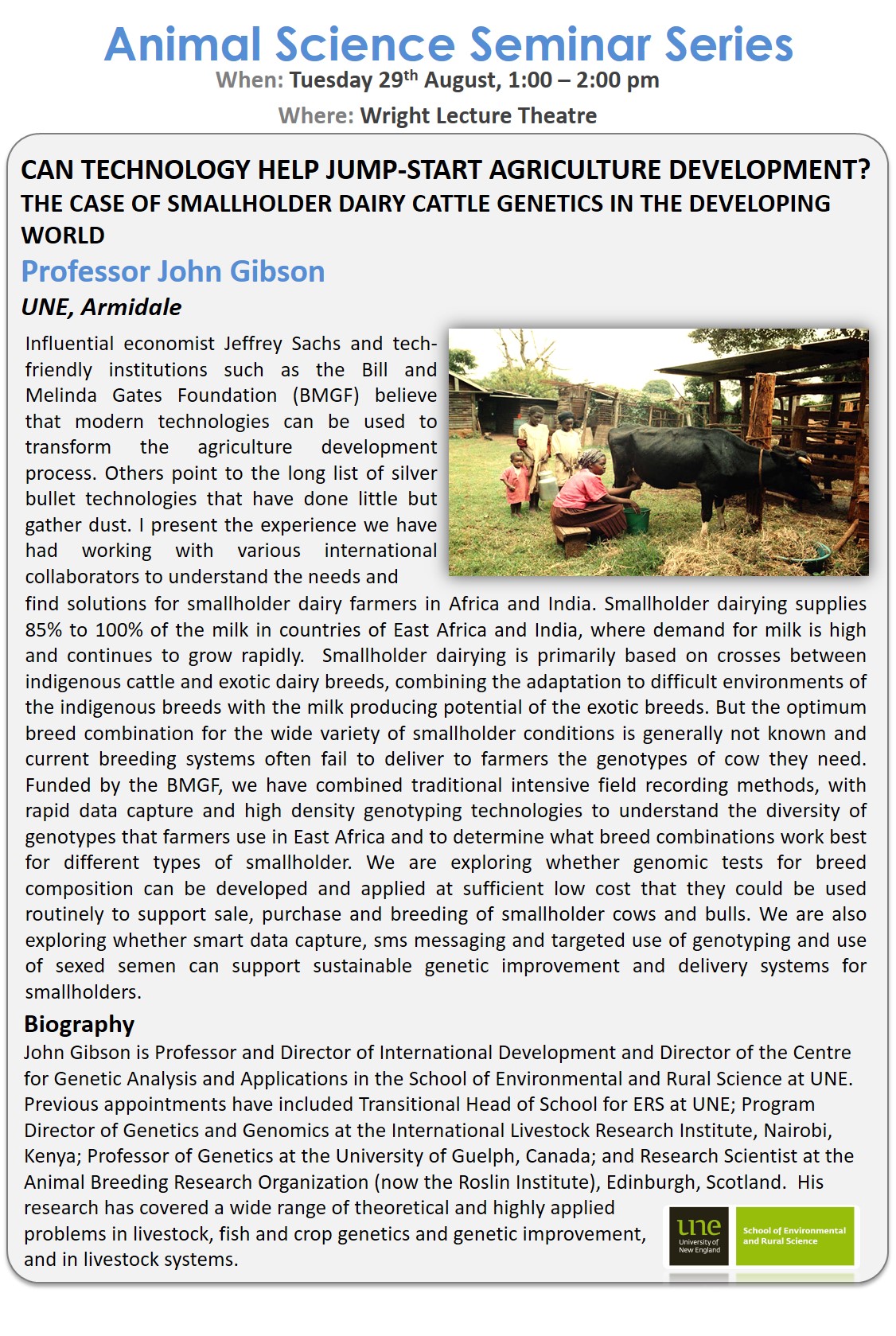
gather dust. I present the experience we have had working with various international collaborators to understand the needs and find solutions for smallholder dairy farmers in Africa and India. Smallholder dairying supplies 85% to 100% of the milk in countries of East Africa and India, where demand for
milk is high and continues to grow rapidly. Smallholder dairying is primarily based on crosses between indigenous cattle and exotic dairy breeds, combining the adaptation to difficult environments of the indigenous breeds with the milk producing potential of the exotic breeds. But the optimum
breed combination for the wide variety of smallholder conditions is generally not known and current breeding systems often fail to deliver to farmers the genotypes of cow they need. Funded by the BMGF, we have combined traditional intensive field recording methods, with rapid data capture and high density
genotyping technologies to understand the diversity of genotypes that farmers use in East Africa and to determine what breed combinations work best for different types of smallholder. We are exploring whether genomic tests for breed composition can be developed and applied at sufficient low cost that
they could be used routinely to support sale, purchase and breeding of smallholder cows and bulls. We are also exploring whether smart data capture, sms messaging and targeted use of genotyping and use of sexed semen can support sustainable genetic improvement and delivery systems for smallholders.
Genomics at the International Livestock Research Institute, Nairobi, Kenya; Professor of Genetics at the University of Guelph, Canada; and Research Scientist at the Animal Breeding Research Organisation (now the Roslin Institute), Edinburgh, Scotland. His research has covered a wide range
of theoretical and highly applied problems in livestock, fish and crop genetics and genetic improvement, and in livestock systems.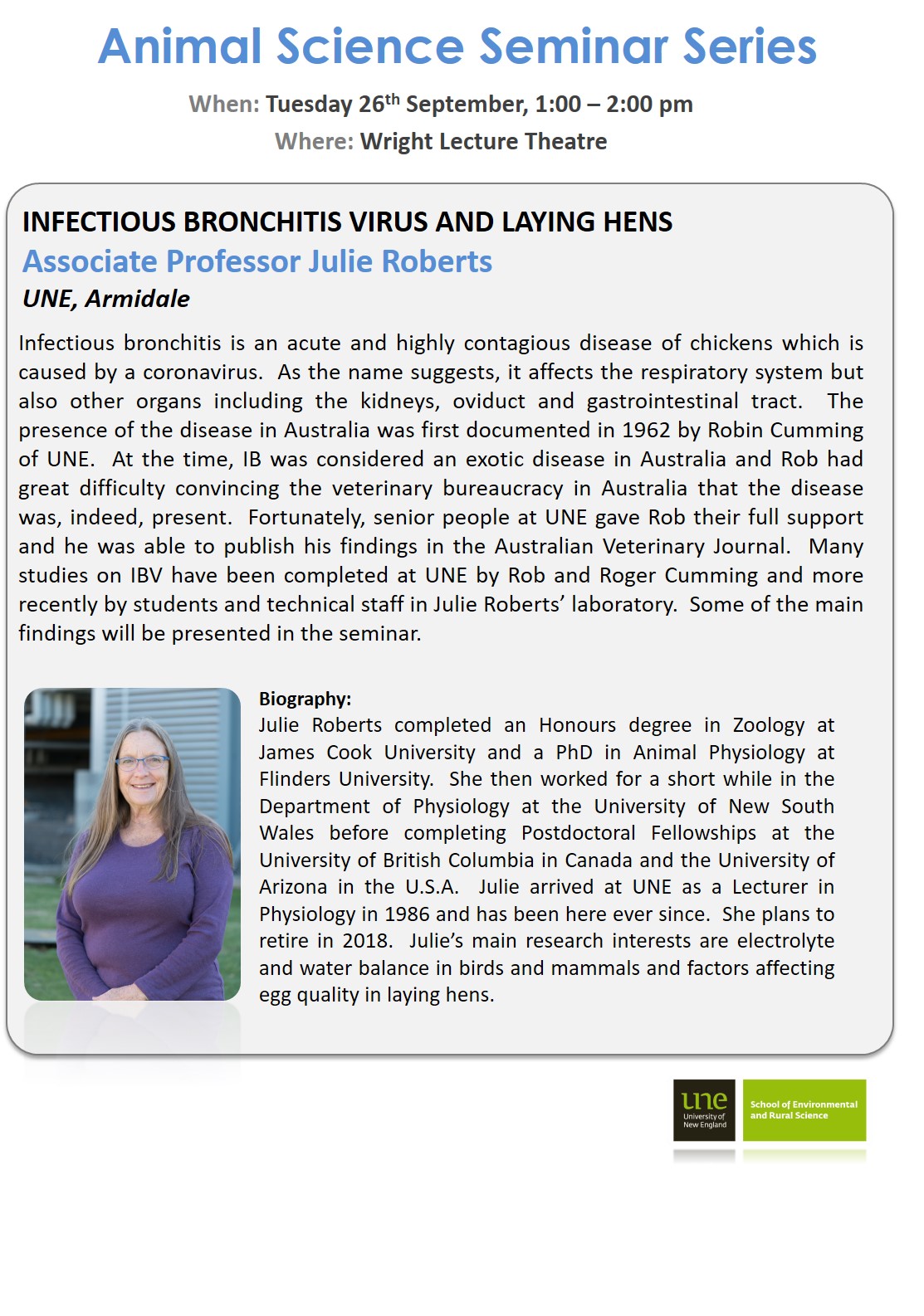
Australia was first documented in 1962 by Robin Cumming of UNE. At the time, IB was considered an exotic disease in Australia and Rob had great difficulty convincing the veterinary bureaucracy in Australia that the disease was, indeed, present. Fortunately, senior people at UNE
gave Rob their full support and he was able to publish his findings in the Australian Veterinary Journal. Many studies on IBV have been completed at UNE by Rob and Roger Cumming and more recently by students and technical staff in Julie Roberts’ laboratory. Some of the main findings
will be presented in the seminar.
of British Columbia in Canada and the University of Arizona in the U.S.A. Julie arrived at UNE as a Lecturer in Physiology in 1986 and has been here ever since. She plans to retire in 2018. Julie’s main research interests are electrolyte and water balance in birds and
mammals and factors affecting egg quality in laying hens.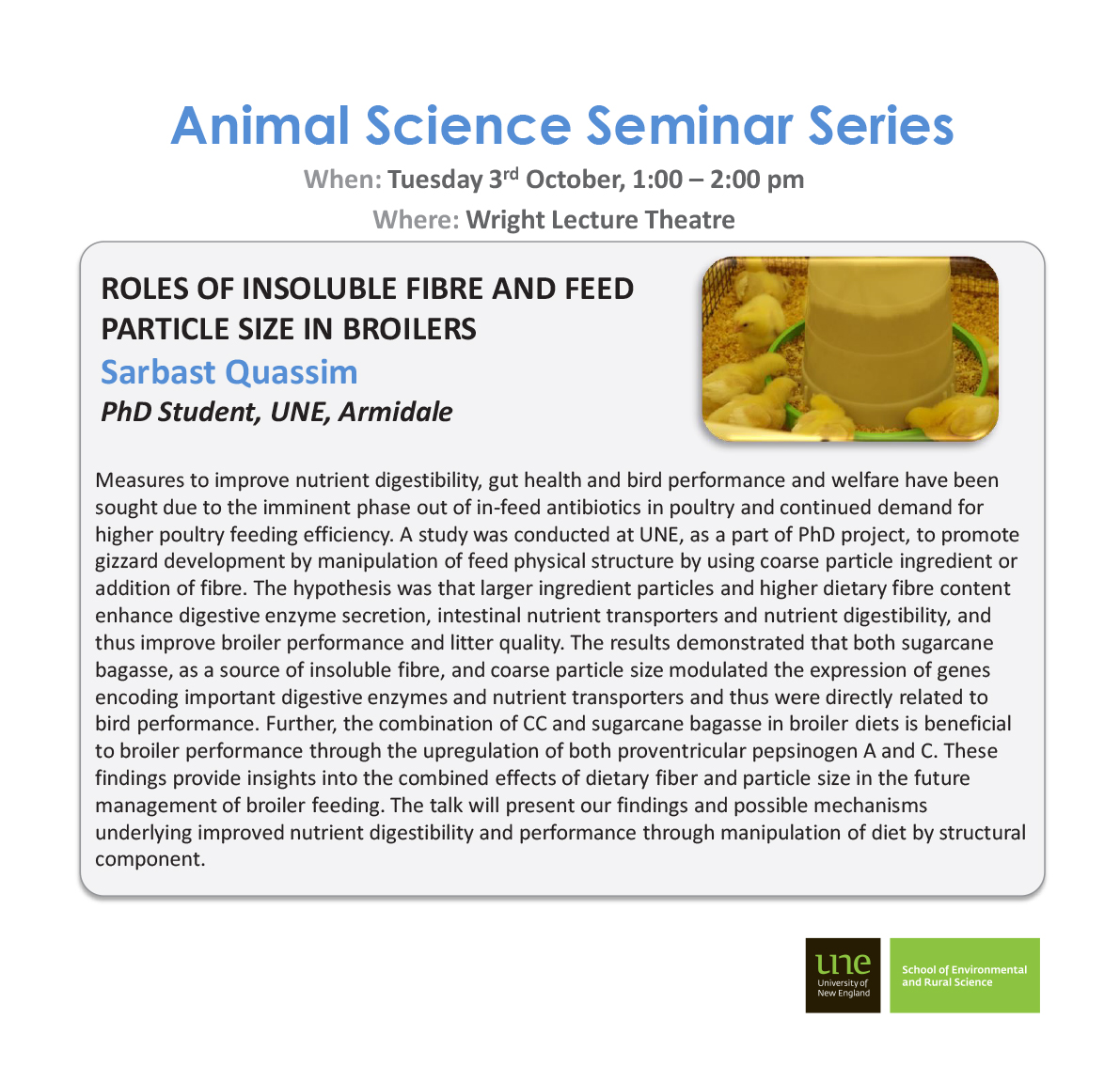
development by manipulation of feed physical structure by using coarse particle ingredient or addition of fibre. The hypothesis was that larger ingredient particles and higher dietary fibre content enhance digestive enzyme secretion, intestinal nutrient transporters and nutrient digestibility, and thus
improve broiler performance and litter quality. The results demonstrated that both sugarcane bagasse, as a source of insoluble fibre, and coarse particle size modulated the expression of genes encoding important digestive enzymes and nutrient transporters and thus were directly related to bird performance.
Further, the combination of CC and sugarcane bagasse in broiler diets is beneficial to broiler performance through the upregulation of both proventricular pepsinogen A and C. These findings provide insights into the combined effects of dietary fiber and particle size in the future management of broiler
feeding. The talk will present our findings and possible mechanisms underlying improved nutrient digestibility and performance through manipulation of diet by structural component.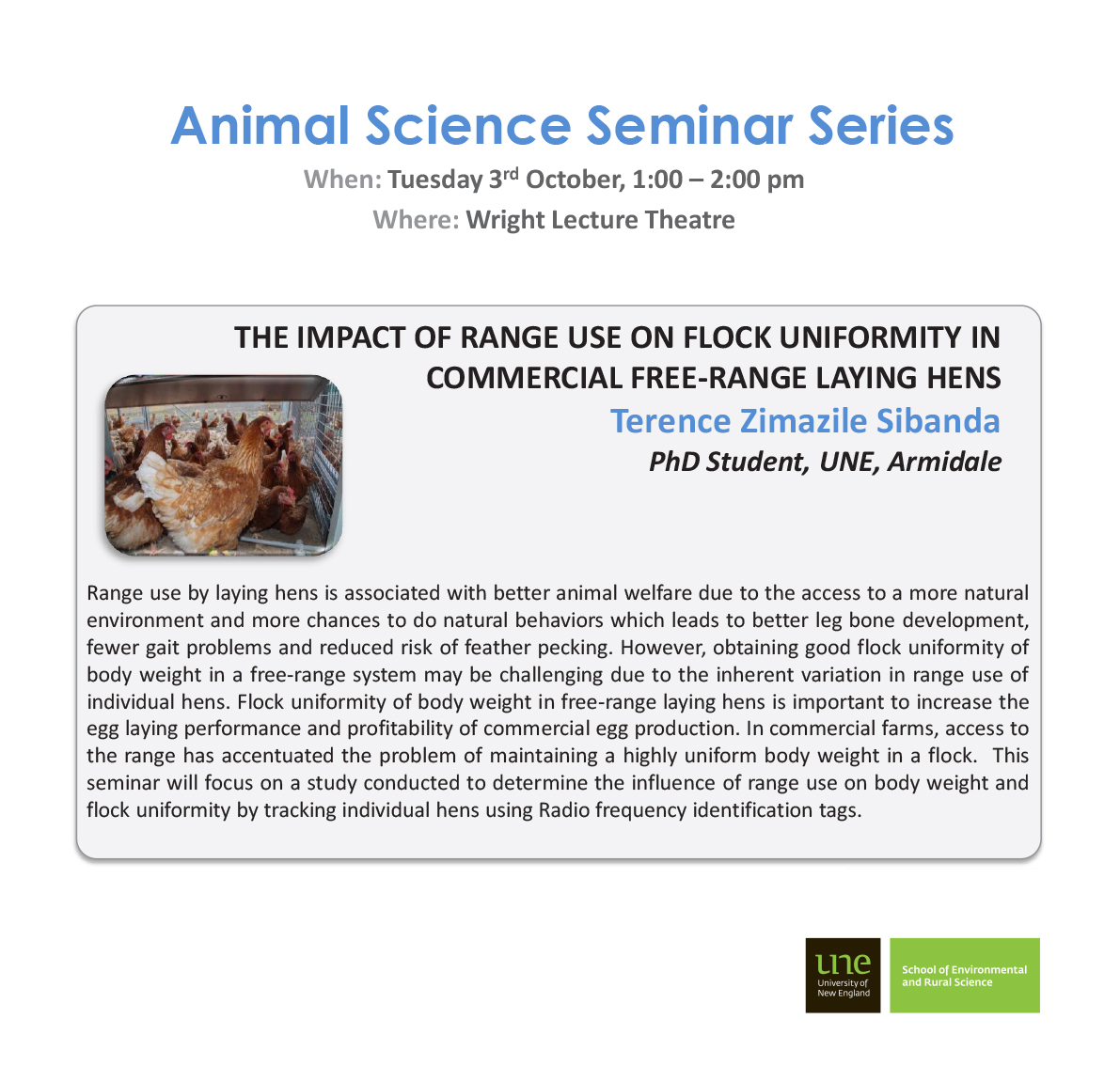
body weight in a free-range system may be challenging due to the inherent variation in range use of individual hens. Flock uniformity of body weight in free-range laying hens is important to increase the egg laying performance and profitability of commercial egg production. In commercial farms, access
to the range has accentuated the problem of maintaining a highly uniform body weight in a flock. This seminar will focus on a study conducted to determine the influence of range use on body weight and flock uniformity by tracking individual hens using Radio frequency identification tags. .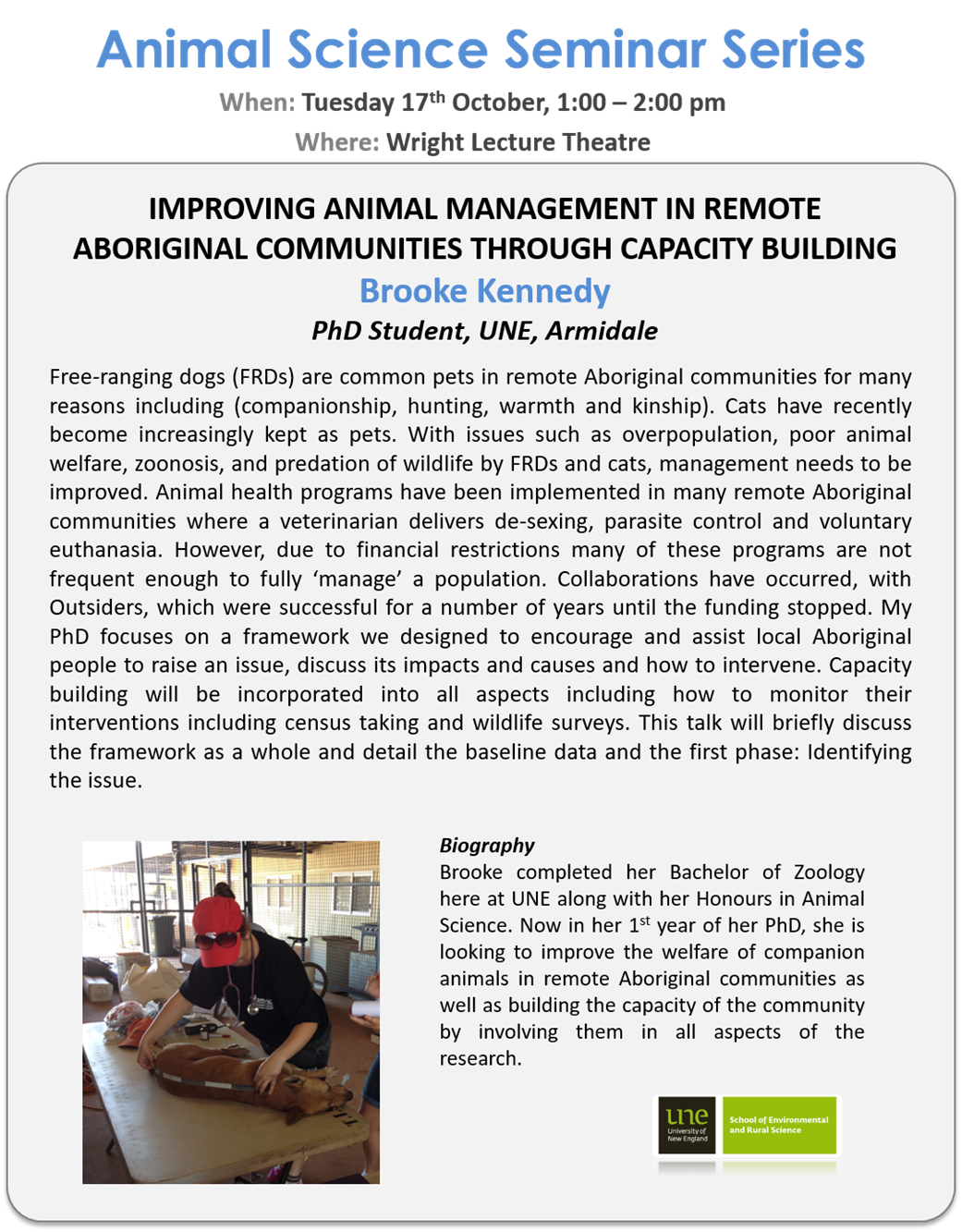
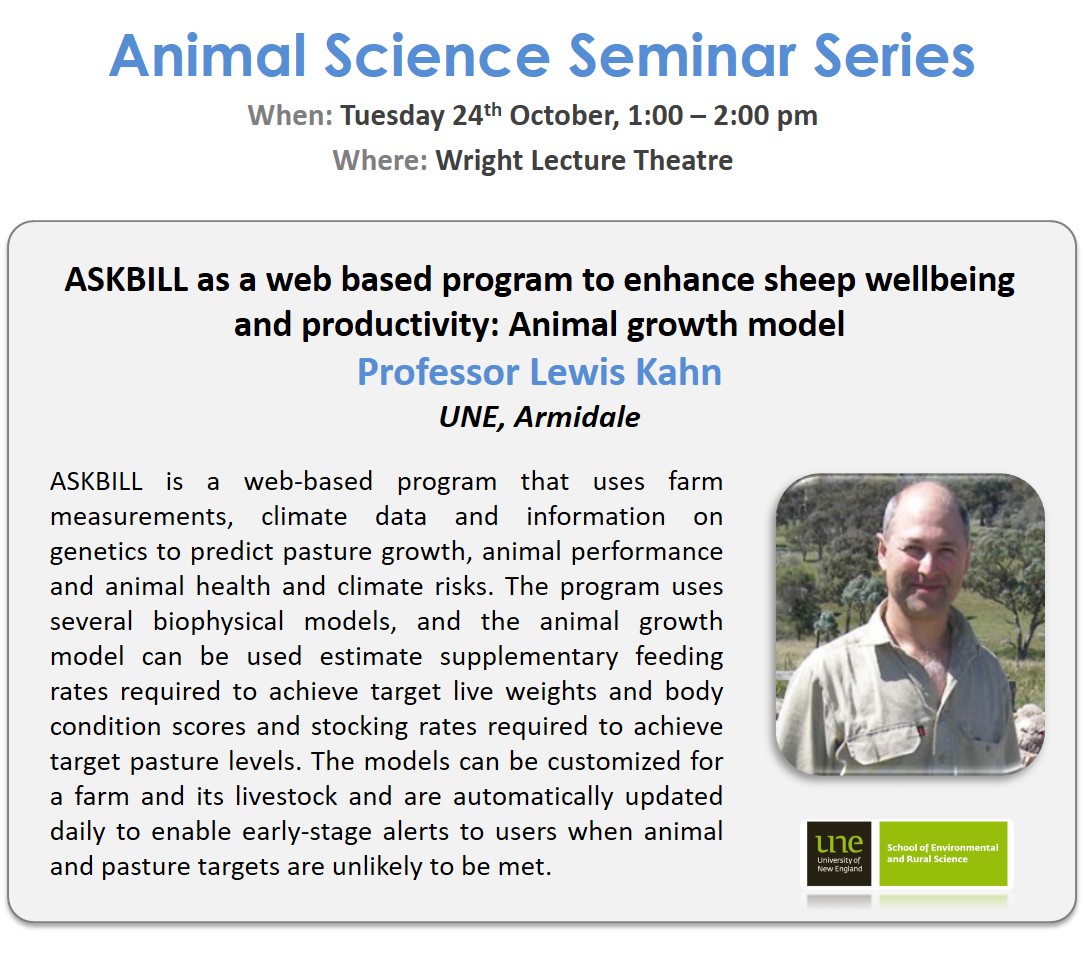
rates required to achieve target live weights and body condition scores and stocking rates required to achieve target pasture levels. The models can be customized for a farm and its livestock and are automatically updated daily to enable early-stage alerts to users when animal and pasture targets are
unlikely to be met.
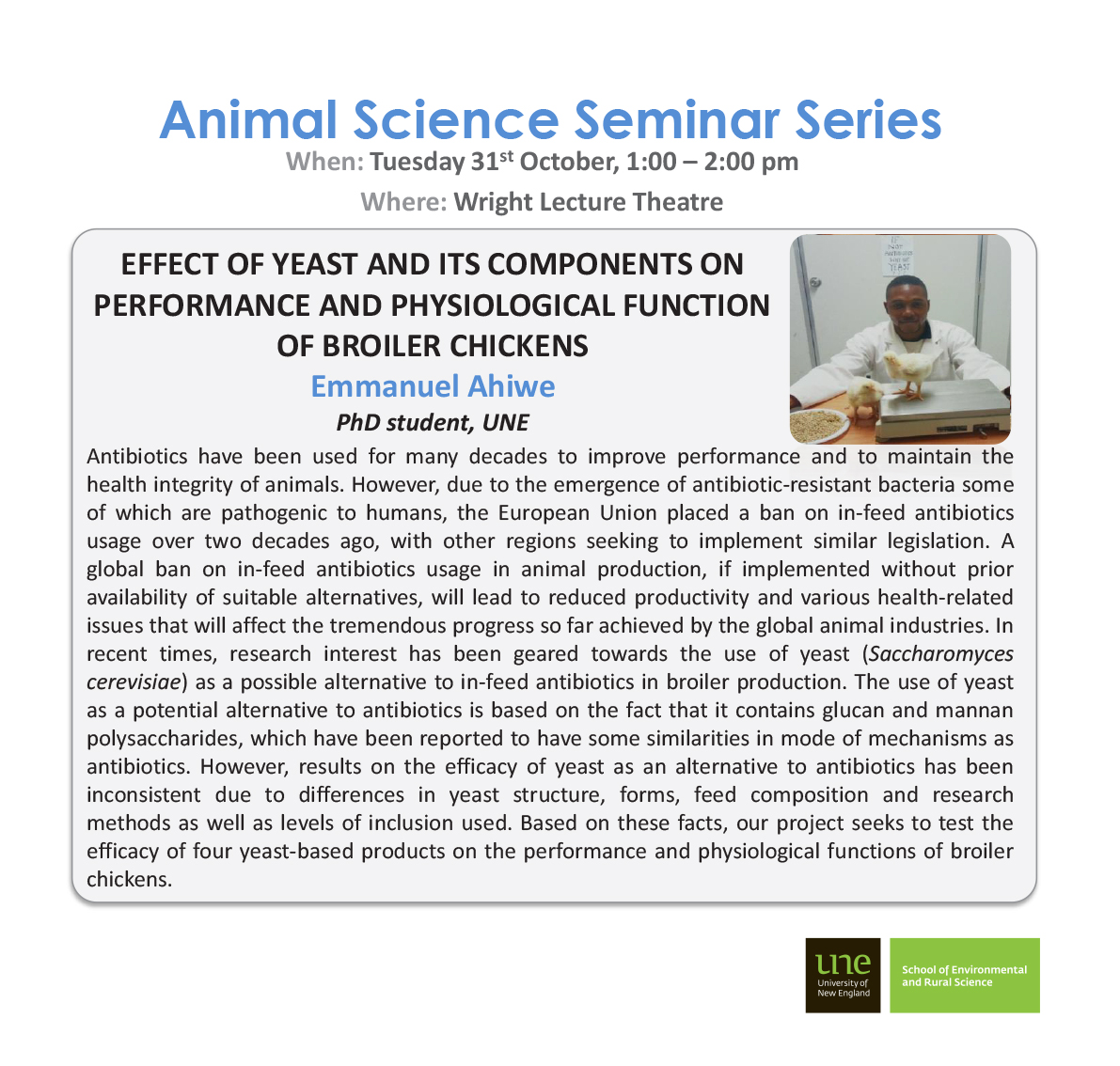
with other regions seeking to implement similar legislation. A global ban on in-feed antibiotics usage in animal production, if implemented without prior availability of suitable alternatives, will lead to reduced productivity and various health-related issues that will affect the tremendous progress
so far achieved by the global animal industries. In recent times, research interest has been geared towards the use of yeast (Saccharomyces cerevisiae) as a possible alternative to in-feed antibiotics in broiler production. The use of yeast as a potential alternative to antibiotics is based on the fact
that it contains glucan and mannan polysaccharides, which have been reported to have some similarities in mode of mechanisms as antibiotics. However, results on the efficacy of yeast as an alternative to antibiotics has been inconsistent due to differences in yeast structure, forms, feed composition
and research methods as well as levels of inclusion used. Based on these facts, our project seeks to test the efficacy of four yeast-based products on the performance and physiological functions of broiler chickens.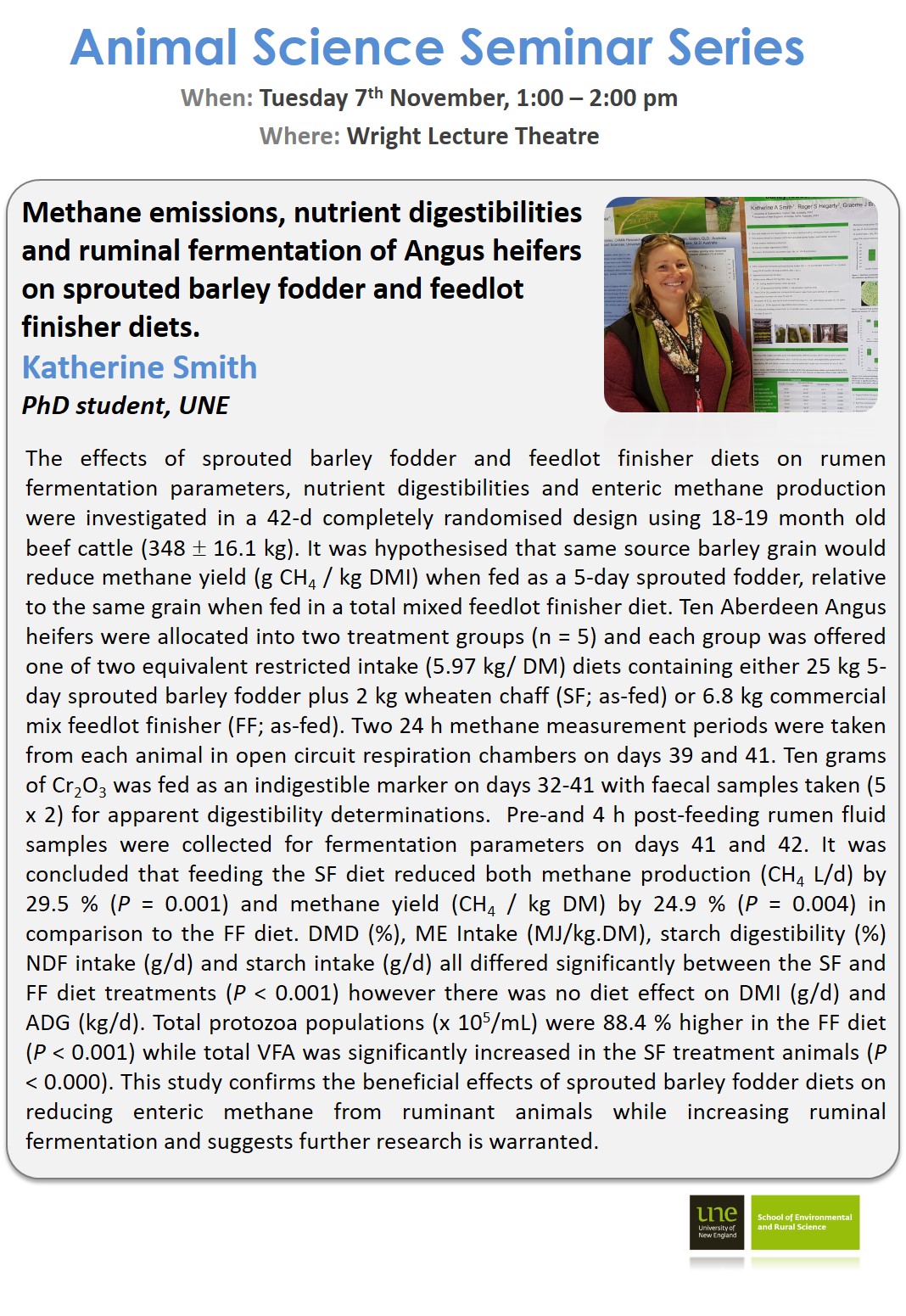
barley grain would reduce methane yield (g CH4 / kg DMI) when fed as a 5-day sprouted fodder, relative to the same grain when fed in a total mixed feedlot finisher diet. Ten Aberdeen Angus heifers were allocated into two treatment groups (n = 5) and each group was offered one of two equivalent restricted
intake (5.97 kg/ DM) diets containing either 25 kg 5-day sprouted barley fodder plus 2 kg wheaten chaff (SF; as-fed) or 6.8 kg commercial mix feedlot finisher (FF; as-fed). Two 24 h methane measurement periods were taken from each animal in open circuit respiration chambers on days 39 and 41. Ten grams
of Cr2O3 was fed as an indigestible marker on days 32-41 with faecal samples taken (5 x 2) for apparent digestibility determinations. Pre-and 4 h post-feeding rumen fluid samples were collected for fermentation parameters on days 41 and 42. It was concluded that feeding the SF diet reduced
both methane production (CH4 L/d) by 29.5 % (P = 0.001) and methane yield (CH4 / kg DM) by 24.9 % (P = 0.004) in comparison to the FF diet. DMD (%), ME Intake (MJ/kg.DM), starch digestibility (%) NDF intake (g/d) and starch intake (g/d) all differed significantly between the SF and FF diet treatments
(P < 0.001) however there was no diet effect on DMI (g/d) and ADG (kg/d). Total protozoa populations (x 105/mL) were 88.4 % higher in the FF diet (P < 0.001) while total VFA was significantly increased in the SF treatment animals (P < 0.000). This study confirms the beneficial effects of sprouted
barley fodder diets on reducing enteric methane from ruminant animals while increasing ruminal fermentation and suggests further research is warranted.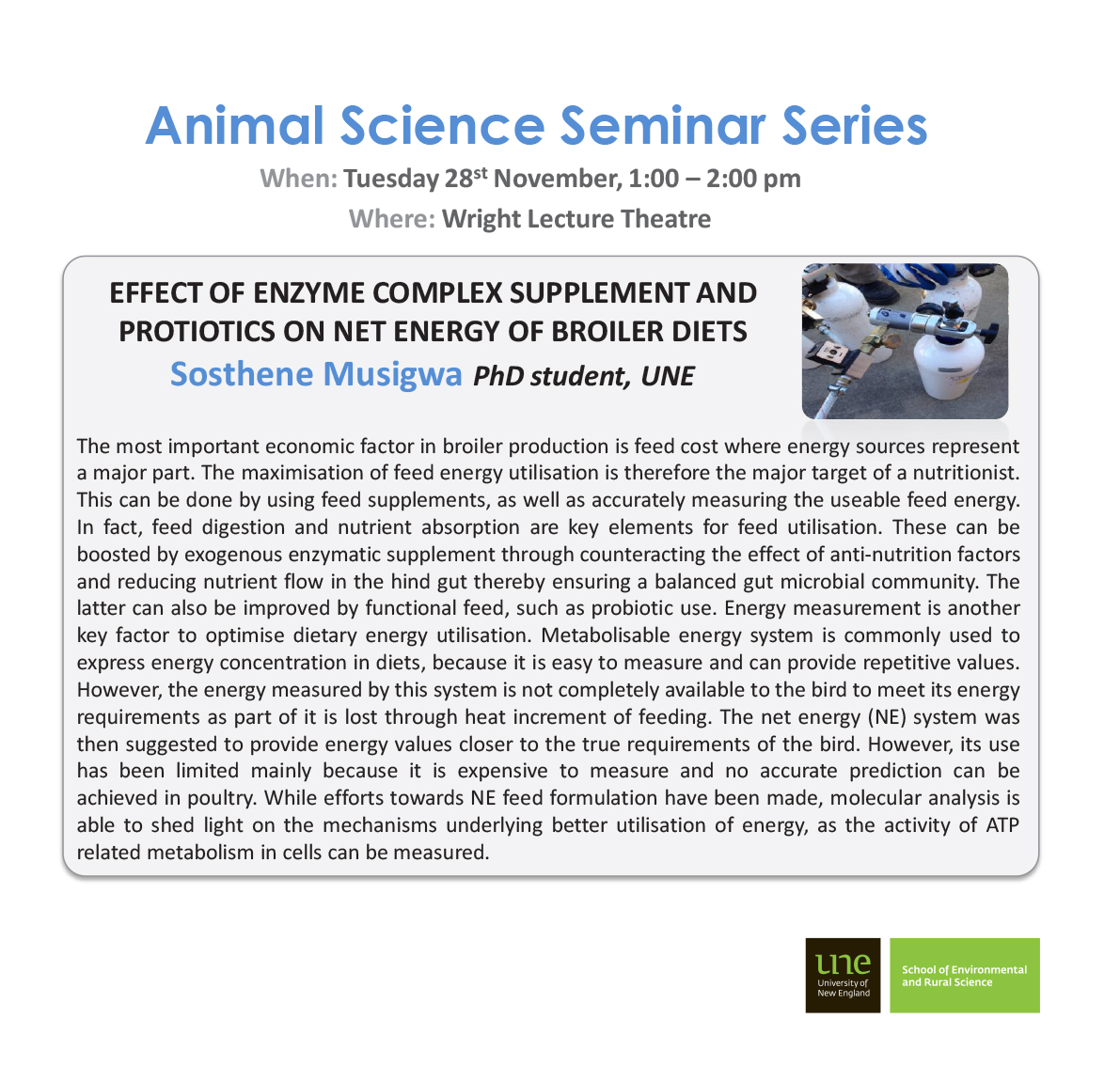
energy. In fact, feed digestion and nutrient absorption are key elements for feed utilisation. These can be boosted by exogenous enzymatic supplement through counteracting the effect of anti-nutrition factors and reducing nutrient flow in the hind gut thereby ensuring a balanced gut microbial community.
The latter can also be improved by functional feed, such as probiotic use. Energy measurement is another key factor to optimise dietary energy utilisation. Metabolisable energy system is commonly used to express energy concentration in diets, because it is easy to measure and can provide repetitive values.
However, the energy measured by this system is not completely available to the bird to meet its energy requirements as part of it is lost through heat increment of feeding. The net energy (NE) system was then suggested to provide energy values closer to the true requirements of the bird. However, its
use has been limited mainly because it is expensive to measure and no accurate prediction can be achieved in poultry. While efforts towards NE feed formulation have been made, molecular analysis is able to shed light on the mechanisms underlying better utilisation of energy, as the activity of ATP related
metabolism in cells can be measured. .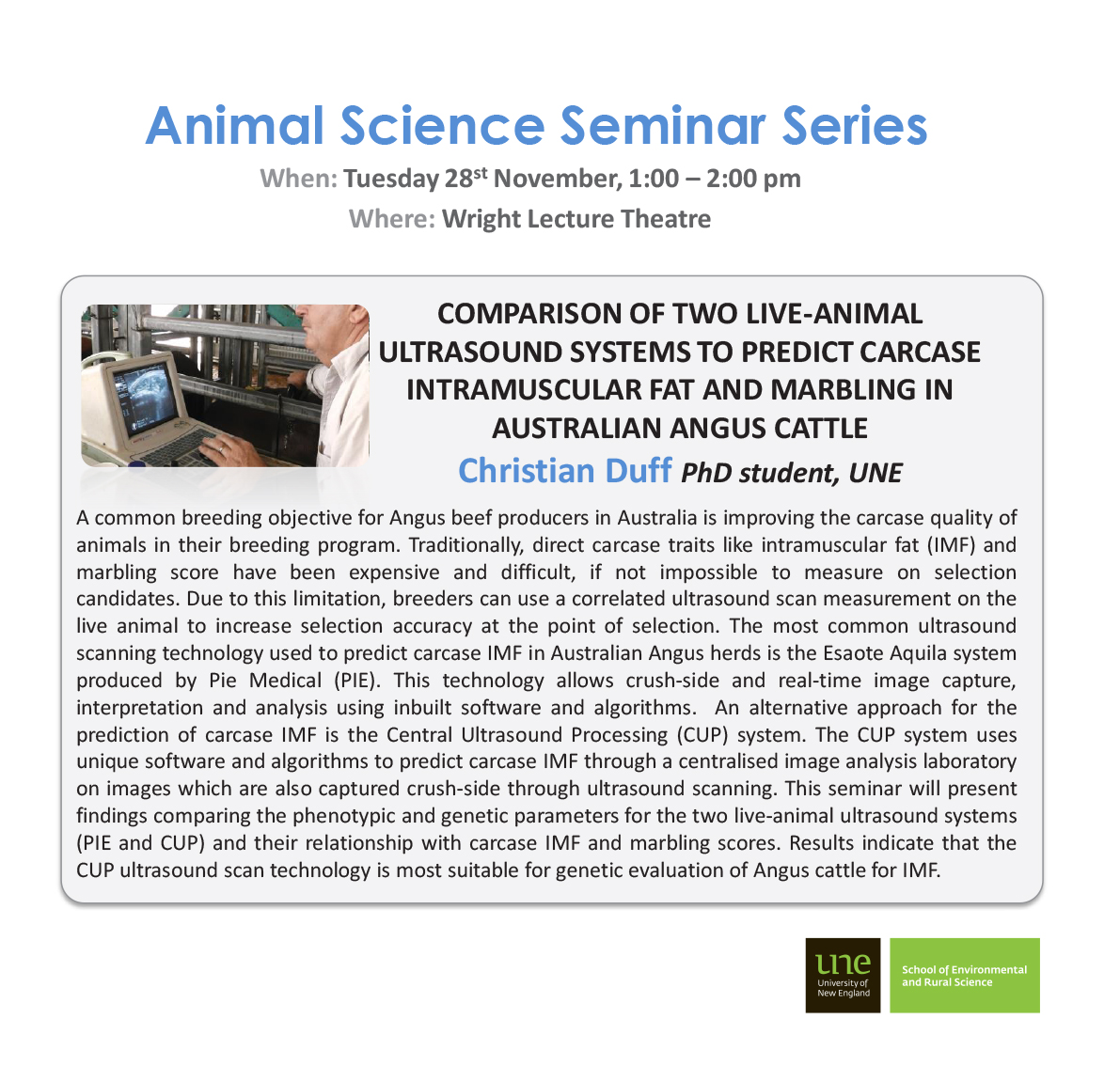
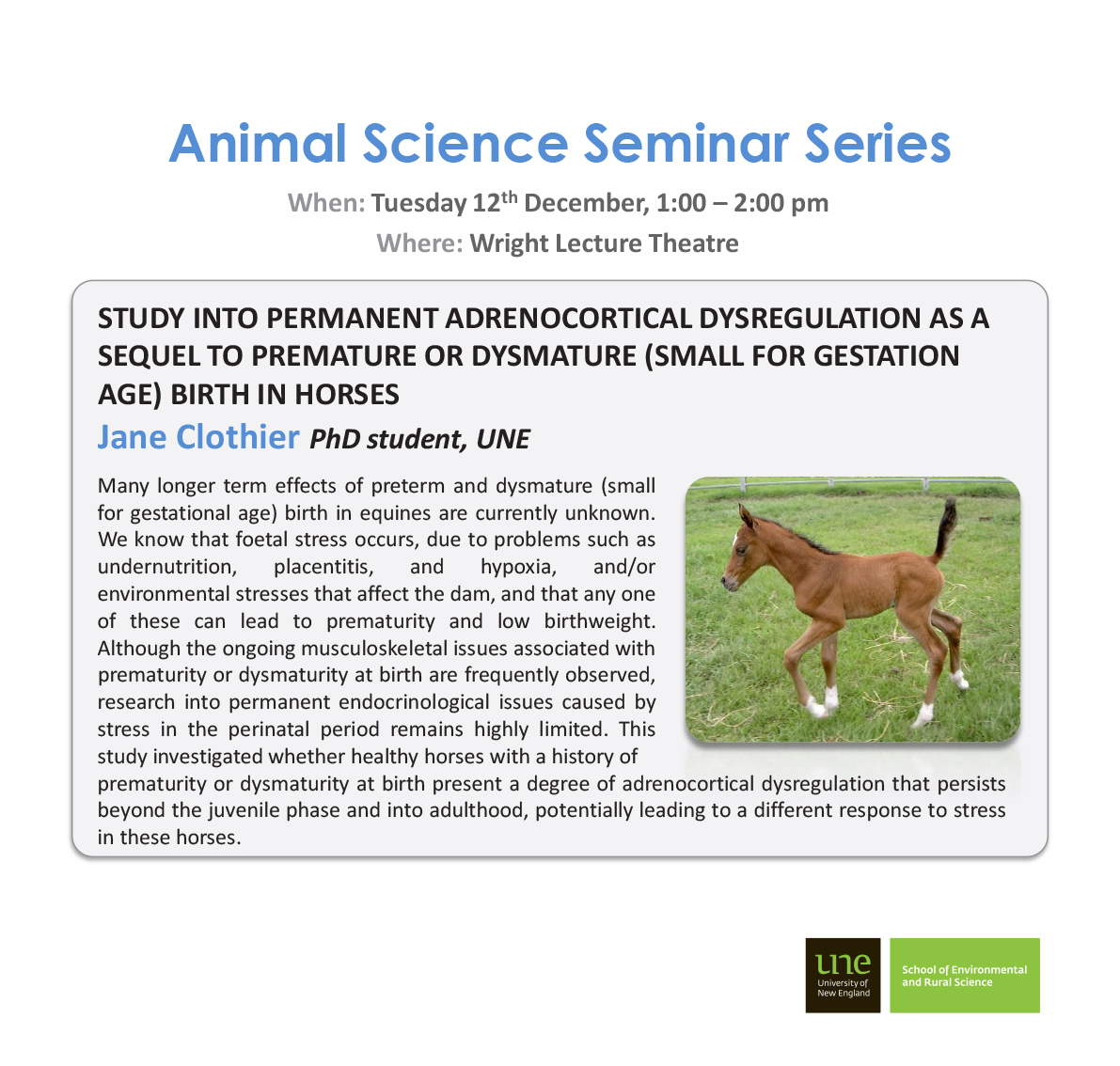
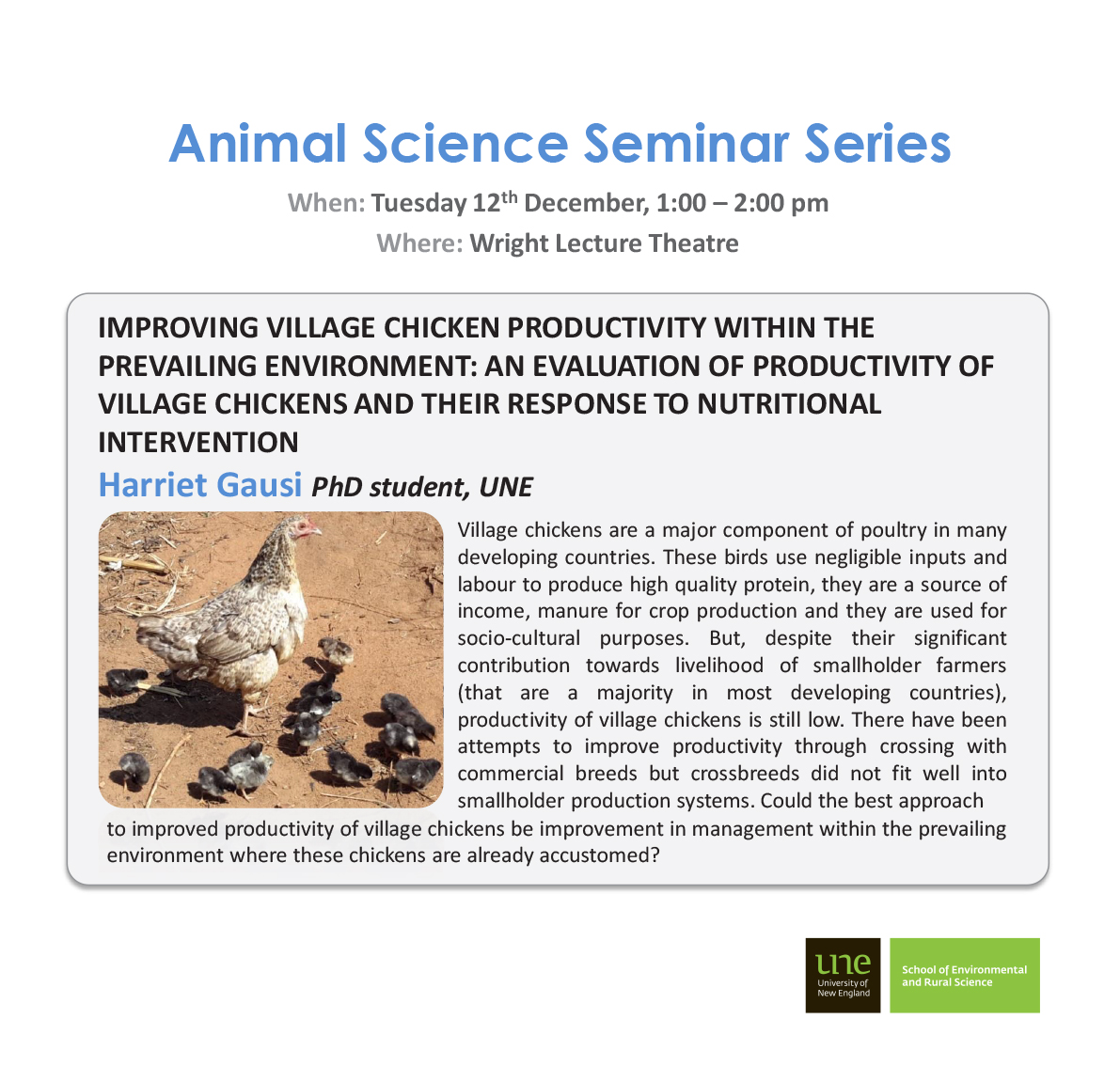
towards livelihood of smallholder farmers (that are a majority in most developing countries), productivity of village chickens is still low. There have been attempts to improve productivity through crossing with commercial breeds but crossbreeds did not fit well into smallholder production systems. Could
the best approach to improved productivity of village chickens be improvement in management within the prevailing environment where these chickens are already accustomed?

